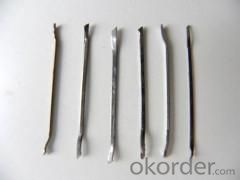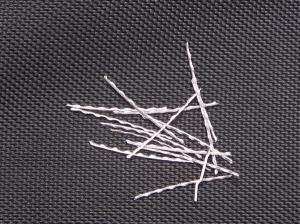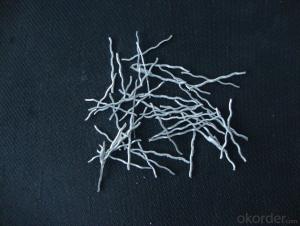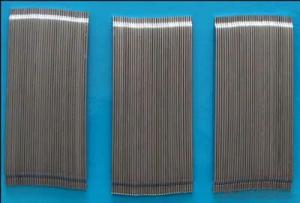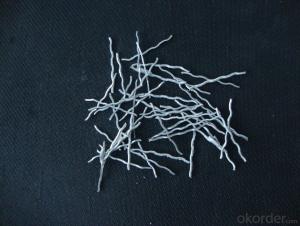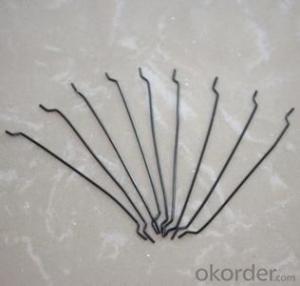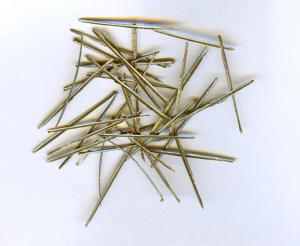Melt Extract Stainless Steel Fiber Reinforced Concrete with Admixtures
- Loading Port:
- Tianjin
- Payment Terms:
- TT OR LC
- Min Order Qty:
- 1000 kg
- Supply Capability:
- 250000 kg/month
OKorder Service Pledge
OKorder Financial Service
You Might Also Like
Quick Details
Place of Origin: Shandong, China (Mainland), Shandong, China (Mainland)
material: steel wire
type: wavy steel fiber
shape: corrugated flat fiber
usage: concrete reinforcement
appearance: clear and bright
Product features
steel fiber are for concrete construction, greatly improves concrete bonding and tensile strength .
The steel fiber is made of high-quality low carbon steel wire,with the characteristic of the high tensile strength,good toughness,etcs.This product is widely used in the construction fields for concrete reinforcement
or the shotcrete for tunnle.According to the standard of JG/T3046-1999 Steel Fiber Concrete, YB/T 151-1999 Steel Fiber for Concrete and ASTM AB820-90 Steel Fiber for the Fiber-Rinforced Concrete.
Specifications
| The Specification of Hooker Ends Steel Fiber | ||||
| TYPE | Diameter(mm) | Length(mm) | Length/Diameter | Tensile strength |
| LB-60/60 | 1.0 | 60 | 60 | >=1000Mpa |
| LB-50/50 | 1.0 | 50 | 50 | >=1000Mpa |
| LB-65/60 | 0.9 | 60 | 65 | >=1000Mpa |
| LB-55/50 | 0.9 | 50 | 55 | >=1000Mpa |
| LB-80/60 | 0.75 | 60 | 80 | >=1000Mpa |
| LB-45/35 | 0.75 | 35 | 45 | >=1000Mpa |
| LB-55/30 | 0.55 | 30 | 55 | >=1000Mpa |
| LB-60/30 | 0.5 | 30 | 60 | >=1000Mpa |
| LB-50/25 | 0.5 | 25 | 50 | >=1000Mpa |
| LB-60/25 | 0.4 | 25 | 60 | >=1000Mpa |
Picture
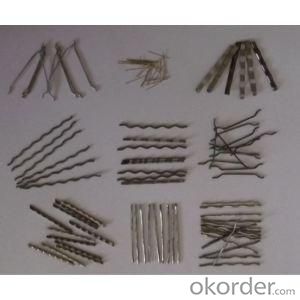
steel fiber for concrete reinforcement
FAQ
we can produce any type steel fiber and of course we can make production according to your requirement
we have specilize in this field for almost 10 years ,with good quality and competitive price
- Q: Can melt extract stainless steel fiber be used in precast tunnel portals?
- Precast tunnel portals can benefit from the utilization of melt extract stainless steel fiber. This material, renowned for its exceptional durability and resistance to corrosion, is widely employed in construction projects, specifically those involving tunnels. The incorporation of stainless steel fiber in tunnel portals serves to bolster the overall sturdiness and longevity of the precast concrete panels. By reinforcing the concrete, it fortifies its ability to withstand cracks and spalling, which is especially crucial due to the substantial stress and impact experienced by tunnel portals. Moreover, stainless steel fiber also enhances the fire resistance of precast panels. It effectively safeguards the concrete against spalling and disintegration when subjected to high temperatures, thus enhancing the structural integrity of the tunnel portal in the event of a fire. Additionally, melt extract stainless steel fiber exhibits remarkable resistance to corrosion, rendering it suitable for use in tunnel portals exposed to harsh environmental conditions, such as moisture and chemicals. It contributes to extending the lifespan of precast panels while minimizing the necessity for frequent maintenance or repairs. In summary, melt extract stainless steel fiber proves to be an effective solution for enhancing the strength, durability, fire resistance, and corrosion resistance of precast tunnel portals. Its integration into the construction process leads to the creation of tunnel portals that are longer-lasting and more dependable.
- Q: Can melt extract stainless steel fiber be used in underground parking structures or garages?
- Melt extract stainless steel fiber is suitable for underground parking structures or garages. It is commonly used in concrete to improve its mechanical properties, such as tensile strength, ductility, and resistance to cracking. In environments where the concrete is exposed to moisture, chlorides, and carbonation, the inclusion of stainless steel fibers can significantly enhance the durability and longevity of the concrete. Corrosion resistance is a key feature of stainless steel fibers, especially in underground structures where concrete may be exposed to moisture and chloride ions that can lead to reinforcement corrosion. By adding stainless steel fibers to the concrete, an extra layer of protection against corrosion is provided, extending the structure's service life. Additionally, the use of stainless steel fibers enhances the structural performance of the concrete by acting as reinforcement. This reinforcement improves the concrete's tensile strength and ductility, preventing cracking and enhancing the overall structural integrity of the parking structure or garage. To sum up, melt extract stainless steel fiber is a beneficial addition to concrete in underground parking structures or garages. Its corrosion resistance and ability to improve the mechanical properties of the concrete make it a suitable choice for enhancing durability and structural performance in these types of structures.
- Q: What is the recommended fiber length for melt extract stainless steel fiber in concrete?
- The recommended fiber length for melt extract stainless steel fiber in concrete is typically between 25mm to 50mm.
- Q: What is the effect of melt extract stainless steel fiber on the crack width of concrete elements?
- The use of melt extract stainless steel fiber in concrete elements has been found to significantly reduce the crack width. The fibers act as reinforcement within the concrete matrix, effectively distributing the stress and preventing the formation and propagation of cracks. This helps to enhance the durability and structural integrity of the concrete elements, making them more resistant to cracking and reducing the risk of failure.
- Q: Can melt extract stainless steel fiber be used in architectural concrete?
- Yes, melt extract stainless steel fiber can be used in architectural concrete. This type of fiber is commonly used in architectural concrete applications due to its high strength and durability. It helps to improve the overall performance and longevity of the concrete structures by enhancing its resistance to cracking, shrinkage, and impact. Additionally, melt extract stainless steel fiber can also enhance the concrete's resistance to corrosion, making it suitable for use in architectural projects where exposure to harsh environmental conditions is a concern. Overall, using melt extract stainless steel fiber in architectural concrete can enhance its structural integrity and aesthetic appeal.
- Q: Can melt extract stainless steel fiber be used in concrete repair or rehabilitation?
- Yes, melt extract stainless steel fiber can be used in concrete repair or rehabilitation. It offers improved durability, crack resistance, and structural reinforcement to the repaired or rehabilitated concrete.
- Q: How does melt extract stainless steel fiber improve the durability of nuclear power plant concrete?
- Enhancing the durability of nuclear power plant concrete is an essential function of melt extract stainless steel fiber. These fibers are specifically designed to withstand the harsh conditions present in nuclear power plants, including exposure to radiation, extreme temperatures, and high levels of moisture. One way in which melt extract stainless steel fiber improves the durability of nuclear power plant concrete is by reinforcing its structural integrity. By adding these fibers, the tensile strength of the concrete is increased, making it more resistant to cracking and spalling. This is particularly important in nuclear power plants, as any damage to the concrete can have severe consequences for the facility's safety and operation. Additionally, the unique properties of stainless steel fibers make them highly resistant to corrosion. Nuclear power plants are exposed to corrosive elements, such as chemicals and moisture, which can gradually deteriorate the concrete. Incorporating melt extract stainless steel fiber into the concrete mix significantly reduces the risk of corrosion, ensuring the long-term durability of the structure. Another advantage of melt extract stainless steel fiber is its ability to enhance the concrete's resistance to thermal stress. As nuclear power plants operate at high temperatures, the concrete structures must be able to withstand expansion and contraction. By adding these fibers, thermal stresses are distributed more evenly, preventing cracks and maintaining the overall integrity of the concrete. Furthermore, melt extract stainless steel fiber effectively mitigates the effects of radiation on nuclear power plant concrete. The fibers act as a radiation shield, absorbing and dispersing harmful radiation that can penetrate the concrete. This not only protects the structural integrity of the concrete but also maintains the safety of plant personnel and the surrounding environment. In conclusion, melt extract stainless steel fiber is crucial in improving the durability of nuclear power plant concrete. By reinforcing structural integrity, resisting corrosion, enhancing resistance to thermal stress, and mitigating the effects of radiation, these fibers ensure the long-term performance and safety of the concrete structures in nuclear power plants.
- Q: What are the main applications of melt extract stainless steel fiber?
- Melt extract stainless steel fiber is extensively used in different industries for various purposes. In the construction industry, it is commonly employed to reinforce concrete, thereby increasing its tensile strength, impact resistance, and durability. This makes it suitable for applications like industrial flooring, tunnels, bridges, and precast elements. In the refractory industry, melt extract stainless steel fiber is added to refractory materials such as castables and gunning mixes to enhance their mechanical properties and resistance to thermal shock. By reinforcing these materials, the stainless steel fibers prevent cracking and improve their overall performance in high-temperature environments. The automotive industry utilizes melt extract stainless steel fiber in the manufacturing of brake pads and linings. These fibers enhance the strength, stability, and heat dissipation capabilities of the brake friction materials, resulting in improved braking performance and increased durability of the brake components. Moreover, melt extract stainless steel fiber finds application in the textile industry for the production of high-performance fabrics and garments. These fabrics require enhanced strength, durability, and resistance to abrasion, which is provided by incorporating stainless steel fibers into the fabric. This makes them suitable for applications such as protective clothing, military gear, and industrial textiles. Additionally, melt extract stainless steel fiber is utilized in the electrical and electronics industry. It is incorporated into various electronic components, including printed circuit boards, to enhance their thermal conductivity and mechanical stability. The stainless steel fibers efficiently dissipate heat and improve the overall performance and reliability of these electronic devices. In summary, melt extract stainless steel fiber has a wide range of applications in industries such as construction, refractory, automotive, textile, and electrical/electronics. Its unique properties contribute to improved strength, durability, thermal conductivity, and mechanical stability in these industries.
- Q: What is the effect of melt extract stainless steel fiber on the toughness of concrete?
- The addition of melt extract stainless steel fiber to concrete can have a positive effect on its toughness. Stainless steel fibers are typically used as reinforcement in concrete to enhance its mechanical properties, including toughness. When incorporated into concrete, these fibers act as tiny reinforcements, helping to distribute stress and prevent cracking. This reinforcement improves the overall toughness of the concrete, making it more resistant to impacts, vibrations, and other external forces. The melt extract stainless steel fibers are particularly effective in enhancing toughness due to their superior strength and durability. They are resistant to corrosion, which ensures their long-term effectiveness in concrete structures. Additionally, their small size and high aspect ratio allow for a better bond between the fibers and the surrounding matrix, further improving the overall toughness of the concrete. Overall, the addition of melt extract stainless steel fiber to concrete leads to an increase in its toughness, making it more resilient and durable. This can be particularly beneficial in applications where concrete is subjected to heavy loads, dynamic forces, or harsh environmental conditions.
- Q: How does melt extract stainless steel fiber impact the load transfer between concrete layers?
- Melt extract stainless steel fiber has a significant impact on the load transfer between concrete layers. When added to the concrete mix, these fibers act as reinforcement, enhancing the tensile strength of the material. This reinforcement helps to distribute the load more evenly across the concrete layers, effectively transferring the applied load from one layer to another. The stainless steel fibers are uniformly dispersed within the concrete matrix, creating an interconnected network that enhances the overall structural integrity. As a result, the fibers prevent crack propagation and limit the development and widening of existing cracks between concrete layers. This behavior is crucial in load-bearing structures, as it improves the load-carrying capacity and durability of the concrete. Furthermore, the presence of melt extract stainless steel fibers helps to mitigate the effects of shrinkage and thermal stresses in concrete. These fibers reduce the likelihood of cracking caused by temperature fluctuations, as they provide reinforcement and prevent the formation of large cracks. This, in turn, enhances load transfer between layers by maintaining the structural integrity of the concrete. In summary, the addition of melt extract stainless steel fibers in concrete significantly improves the load transfer between layers. These fibers reinforce the concrete matrix, distribute the applied load more evenly, prevent crack propagation, and mitigate shrinkage and thermal stresses. Ultimately, this results in a stronger, more durable concrete structure with enhanced load-carrying capacity and longevity.
Send your message to us
Melt Extract Stainless Steel Fiber Reinforced Concrete with Admixtures
- Loading Port:
- Tianjin
- Payment Terms:
- TT OR LC
- Min Order Qty:
- 1000 kg
- Supply Capability:
- 250000 kg/month
OKorder Service Pledge
OKorder Financial Service
Similar products
Hot products
Hot Searches
Related keywords



